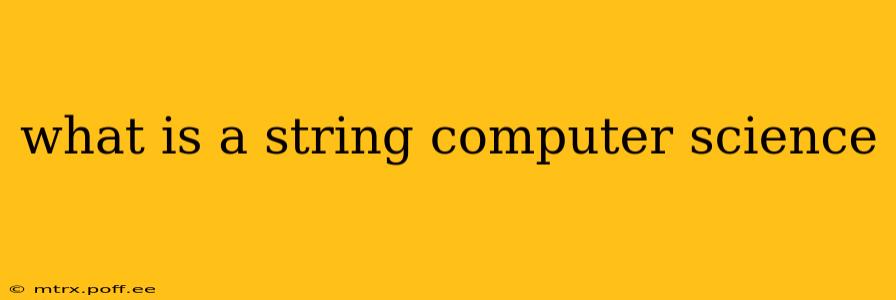In computer science, a string is a sequence of characters. These characters can be letters, numbers, symbols, or whitespace (spaces, tabs, newlines). Think of it like a sentence, a word, or even a single character—all are considered strings. However, unlike mathematical strings which can be infinitely long, strings in computer science are finite sequences with a defined beginning and end. Understanding strings is fundamental to programming as they are used extensively in various applications, from processing text to manipulating data.
Why are Strings Important in Computer Science?
Strings are ubiquitous in computer science because they represent textual data. This makes them crucial for a vast range of applications, including:
- Text Processing: Analyzing, manipulating, and searching through large amounts of text data (e.g., natural language processing, search engines).
- Data Representation: Storing and retrieving information such as names, addresses, and product descriptions in databases.
- User Interfaces: Displaying information to users and receiving input from them.
- Web Development: Creating dynamic and interactive websites, handling user interactions, and managing data.
- Networking: Transmitting and receiving data over networks, often in the form of textual commands or messages.
How are Strings Represented in Computer Memory?
Computers store strings as arrays of characters. Each character is assigned a numerical value (typically using ASCII or Unicode encoding). This means a string "Hello" is internally represented as a sequence of numerical codes corresponding to the letters H, e, l, l, and o. The length of the string is the number of characters it contains. Different programming languages might have slightly different ways of handling strings, including how they manage memory allocation and string operations.
Common String Operations
Many operations are available for manipulating strings. These include:
- Concatenation: Joining two or more strings together (e.g., "Hello" + " World" = "Hello World").
- Substrings: Extracting a portion of a string (e.g., extracting "World" from "Hello World").
- Searching: Finding a specific character or substring within a string.
- Replacing: Substituting one character or substring with another.
- Comparing: Determining whether two strings are equal or comparing their lexicographical order.
- Conversion: Changing a string to a different data type (e.g., converting a string representation of a number to an integer).
- Case Conversion: Converting a string to uppercase or lowercase.
What is the difference between a string and a character?
A character is a single element within a string. Think of a string as a sentence and a character as a single letter or symbol in that sentence. A string comprises one or more characters, while a character is a single unit.
What data structures are used to implement strings?
Strings are often implemented using arrays or dynamic arrays (like vectors). These data structures efficiently store and access sequences of characters. Some languages may utilize more sophisticated structures for performance optimization, particularly when dealing with very large strings.
How are strings handled in different programming languages?
Most programming languages provide built-in support for strings and offer a rich set of functions for string manipulation. However, the specific syntax and functionality can vary across languages. For example, Python offers a flexible and versatile string type with many built-in methods, while C requires more manual memory management. Understanding a language's string handling capabilities is essential for effective programming.
This overview should provide a solid foundation for understanding strings in computer science. Further exploration into specific programming languages and their string libraries will deepen your knowledge and capabilities.
